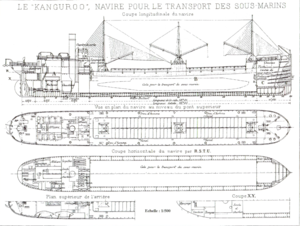SS Kanguroo

Plan and elevation drawings of Kanguroo
|
|
| History | |
|---|---|
|
|
|
| Name: | Kanguroo |
| Namesake: | Kangaroo |
| Owner: | Schneider et Cie |
| Builder: | Forges et Chantiers de la Gironde, Bordeaux |
| Launched: | 12 April 1912 |
| Maiden voyage: | 1912 |
| Fate: | Requisitioned by the French Navy, 1914 |
|
|
|
| Acquired: | Requisitioned, 1914 |
| Fate: | Sunk by U-38, 3 December 1916 |
| General characteristics | |
| Type: | Heavy-lift ship |
| Tonnage: | 2,493 gross register tons (GRT) |
| Displacement: | 5,630 t (5,540 long tons) |
| Length: | 93 m (305 ft 1 in) |
| Beam: | 12 m (39 ft 4 in) |
| Draft: | 5.95 m (19 ft 6 in) |
| Installed power: | 850 PS (630 kW) |
| Propulsion: |
|
| Speed: | 10 knots (19 km/h; 12 mph) |
| Capacity: | 3,830 t (3,770 long tons) |
| Crew: | 22 |
SS Kanguroo was a French heavy-lift ship built to transport submarines before World War I. She delivered submarines to Brazil and Peru before the war began. Requisitioned in 1914 by the French Navy, she was torpedoed by a German submarine in late 1916 and sunk at Funchal, Madeira.
Kanguroo was a ship built to transport submarines for the shipbuilder Schneider et Cie. The company's submarines were too small and their endurance too limited to cross the oceans on their own. Schneider deemed towing them too risky so the company commissioned a purpose-built ship to deliver them safely to their destination. She was 93 meters (305 ft 1 in) long with a beam of 12 meters (39 ft 4 in) and a draft of 5.95 meters (19 ft 6 in). The 2,493-gross register ton (GRT) shipdisplaced 5,630 metric tons (5,540 long tons) and could carry out-sized cargo up to 3,830 metric tons (3,770 long tons) in weight. Kanguroo was powered by a 850-metric-horsepower (630 kW) triple-expansion steam engine driving a single shaft that gave her a speed of 10 knots (19 km/h; 12 mph). She had a crew of four officers and eighteen enlisted crewmen.
The ship was essentially a self-propelled floating dry dock with three main sections. The stern contained the engine, bridge, crew accommodations, workshops, pumps, electric generators and storage facilities for the submarine's torpedoes. The submarine's batteries were kept charged during the voyage by the current from the generators. The middle section consisted of a 58-meter (190 ft 3 in) double-hulled well deck with ballast tanks between its inner walls and the outer hull. The well deck had a capacity of 3,300 cubic meters (120,000 cu ft) and was closed off by a pair of water-tight doors at its forward end. The outer plating and structural members of Kanguroo's bow were designed to be partially dismantled to give access to the short tunnel through the bow to the well deck. Additional ballast tanks were positioned below and on each side of the tunnel to raise and lower the bow.
...
Wikipedia
